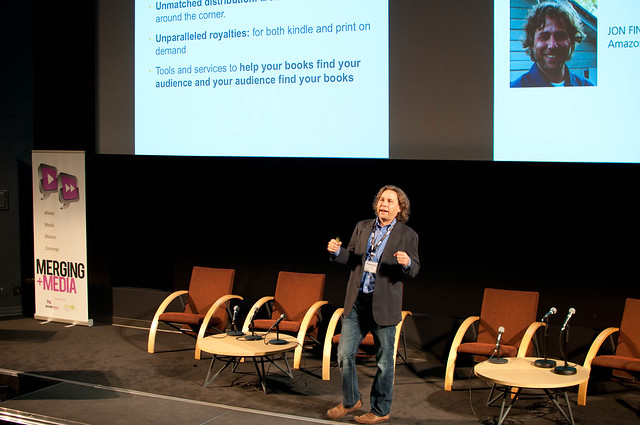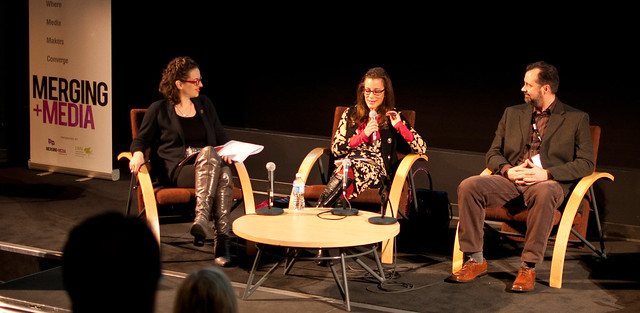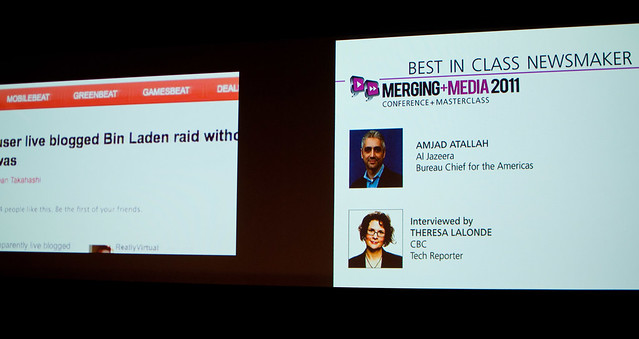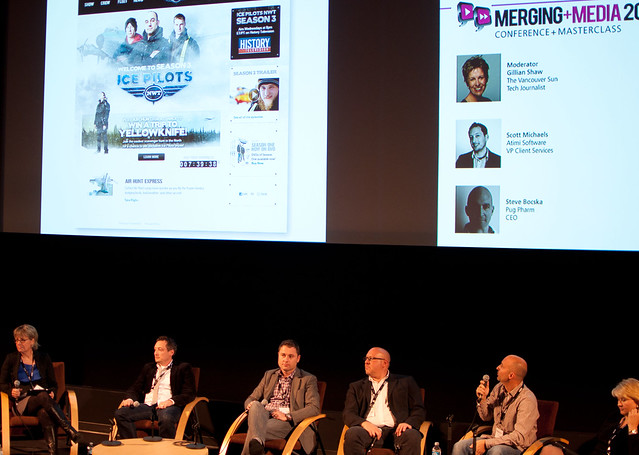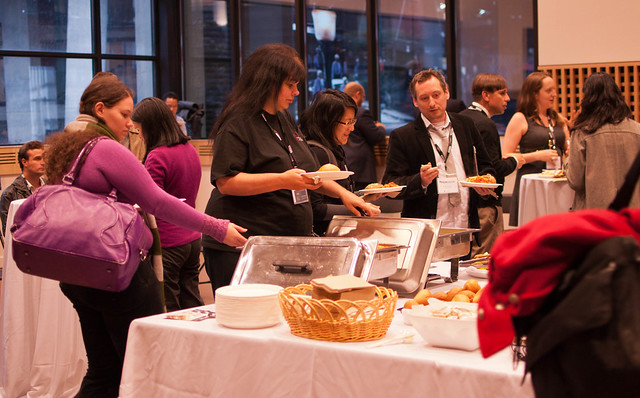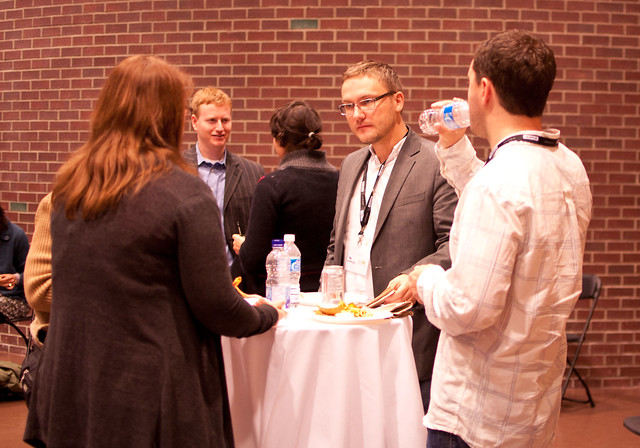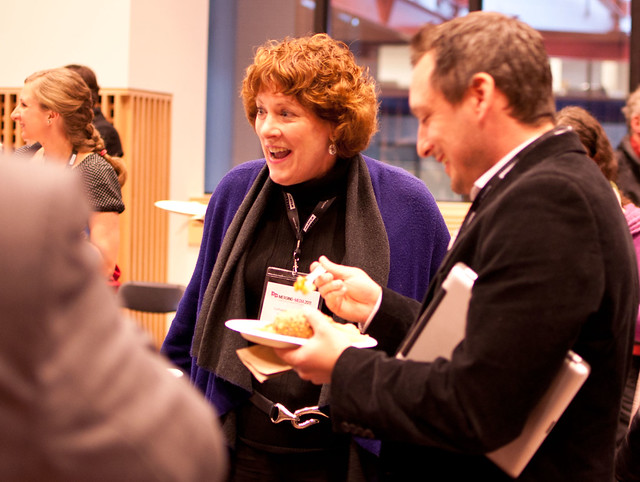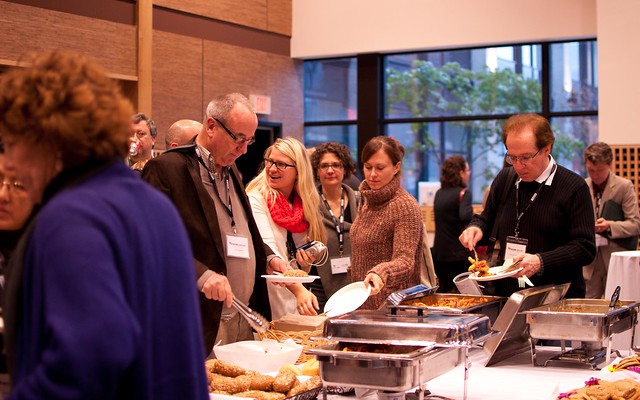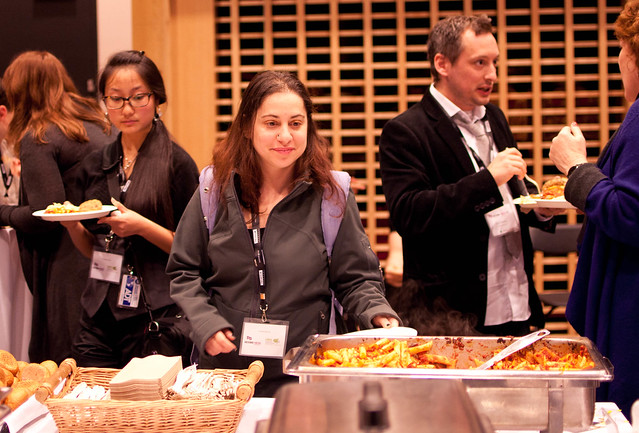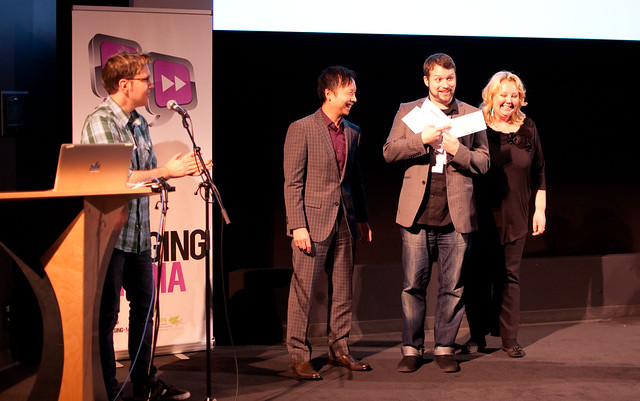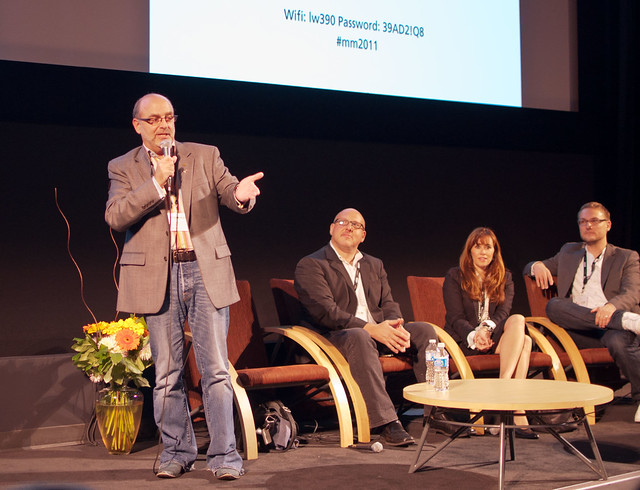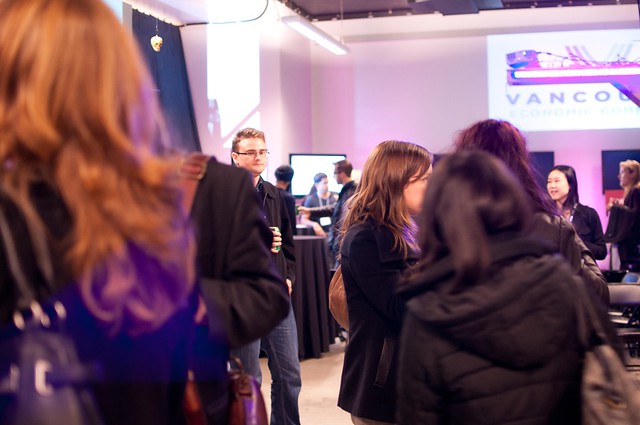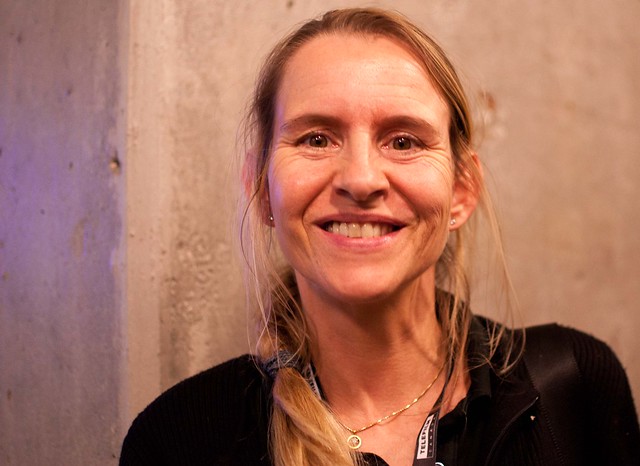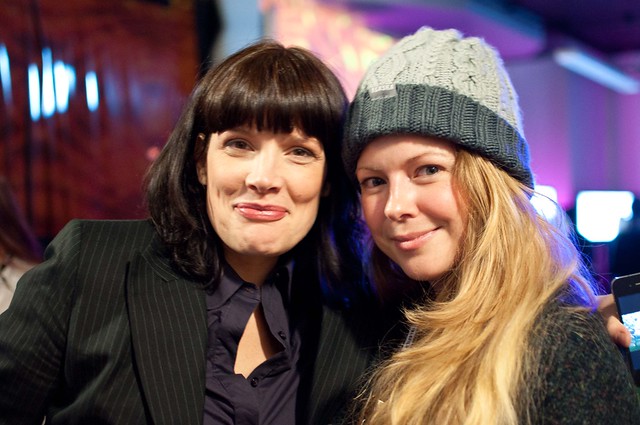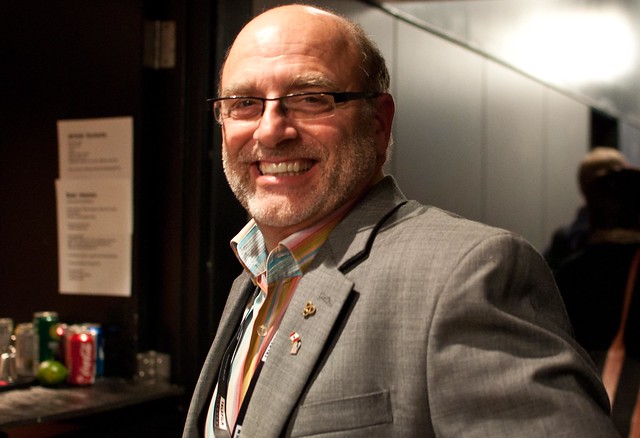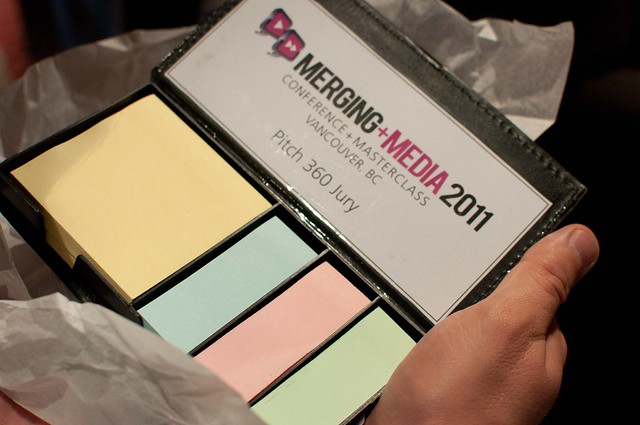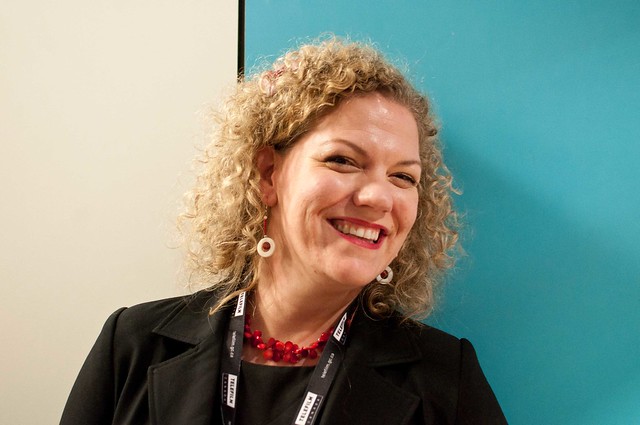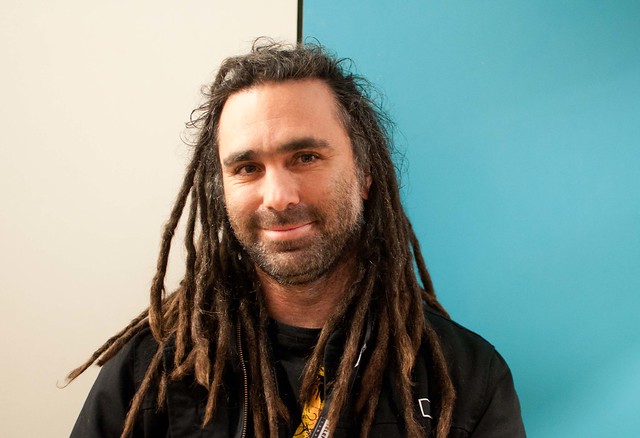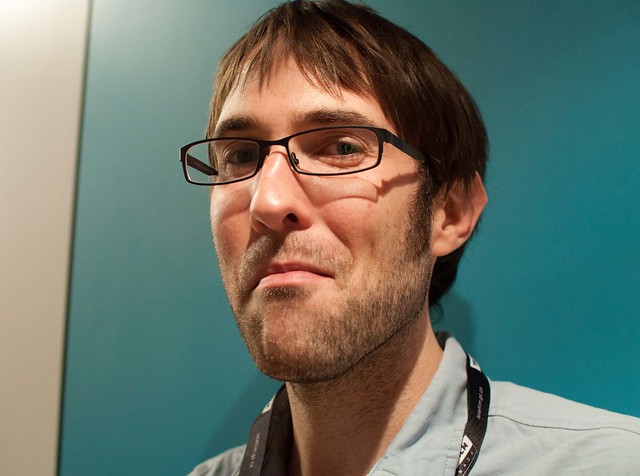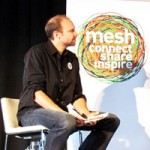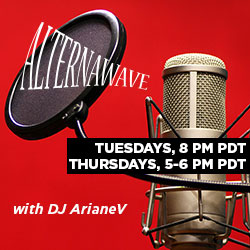On Friday, I attended four of the five Merging Media Conference panels, skipping out on the Pitch 360 project in order to post my recap of Day 1.
Day 2 was equally captivating, and I greatly enjoyed both Theresa Lalonde’s interview with Al Jazeera Bureau Chief Amjad Atallah and convergence guru Henry Jenkins‘ conversation via Skype.
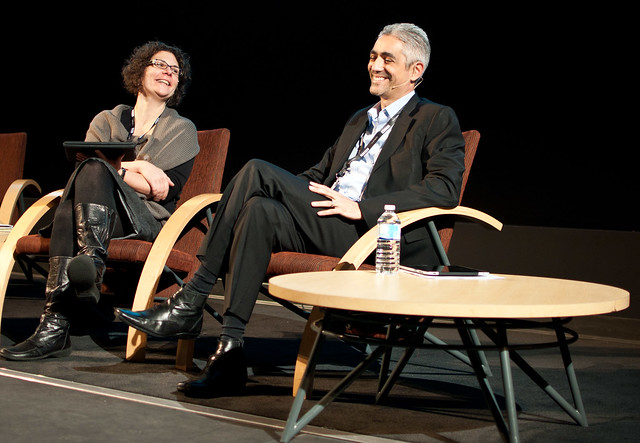
[Theresa Lalonde interviews Al Jazeera’s Amjad Atallah]
This was an enormously enjoyable conference, one that I look forward to attending in future years. A big thank you to the organizers and staff who made this event possible!
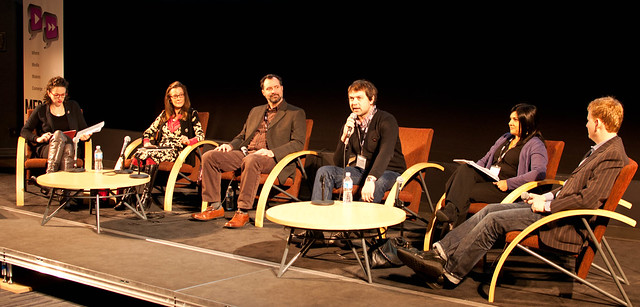
[The Social Screen panel, moderated by Alexandra Samuel]
THE SOCIAL SCREEN
Fans remember brand messaging more than any component of an ad campaign.
The question is how to turn gaming experiences into revenue. Companies can benefit from a full-time social economist who can monitor audiences while observing trends, according to Catherine Warren (FanTrust).
Longer engagement via sponsors: By plugging in a video during a show, the bump (increase) in viewership can be measured to track the video’s success. Social media doesn’t always need to play a financial role, but can provide a greater picture of both users and behaviour (Evan Jones, Stitch Media).
Stitch Media recently used three well-known actors (from Trailer Park Boys) who don’t share a huge relationship with their fans. Social interaction gave their fan base a chance to interact (via Facebook). This was a great example of converting an established fan base to a social one.
There’s a clear audience demand for actively sharing and discussing CBC’s programs. Prompting engagement during a show (with other fans) is a technology that’s quickly evolving. CBC currently sees this as a time experiment (Jonathon Carrigan, CBC).
As more people start to engage with mobile devices, the apps and technology will only improve.
Catherine Warren discussed live tweeting during a show’s premiere. Live tweeting became so successful that both a casual game and tv show about the game that her company produced was launched for the following season. Fans felt part of the process, getting a behind-the-scenes look at the making of the game.
A recurring theme in the panel was user control and interaction.
J Joly (Overinteractive Media): “A/B testing is key. If something doesn’t work, fix it.” While discussing a new client relationship, he brought up the “one year learning, one year earning” concept.
Evan Jones (from Stitch Media) added, “You have to be a fan of what you’re making.”

[Prem Gill, Telus, at Social Screen panel]
CBC faces a few organizational and logistical challenges:
– The different time zones issue: no fluid conversation is happening with the audience, especially with live engagement.
– Pre-canned shows close off a lot of opportunities
– How can an audience be impacted building up to a show, even in between show breaks for advertising? Show breaks can also become interactive and a huge earning revenue potential.
BEST IN CLASS NEWSMAKER with Amjad Atallah, Al Jazeera Bureau Chief for the Americas – interviewed by Theresa Lalonde, CBC’s Technology Reporter)
70 Al Jazeera bureaus are accessed around the world in both Arabic and English, with broadcast centres currently in Kuala Lumpur, London, and Washington DC.
Web and TV are separate. Regardless of who gets the information, the two departments work in tandem. What goes online doesn’t necessarily go on TV. TV looks at the global context. One may go before the other, and it works this way on a 24/7 basis.
Al Jazeera doesn’t want to be a content aggregator. At the core, journalists need to be at the site, where the respective bureau calls in, and a discussion takes place to decide what goes on air. There’s a division set up to monitor videos and sources to ensure accuracy before clips get aired. Arab governments tend to create problems by doctoring videos and providing false leads.
Eye witnesses also help to confirm a content’s accuracy. Local contacts are in place, and this is a very labour-intensive process.
Crowd-source element of social networks is obvious. If something appears inaccurately, the Twitter stream will eventually confirm whether the event is real or faked. Twitter’s crowd sourcing winds up being a sort of fact checker.
Stories need to fit Al Jazeera’s editorial vision. Does the video inform the audience, or is it shown merely for “razzle-dazzle”?
Interactivity between individuals who happened to be there aiding the news story and the actual reporters has become second nature.
Bin Laden: Within a day, Al Jazeera was running stories in all regions where there were victims. Reporters were everywhere, documenting people’s response to his death.
Al Jazeera can’t keep up with its followers on Twitter. Social media has created a more intimate space with real-time engagement. Al Jazeera’s viewers feel a sense of affinity, but also one of accountability. The bureau will hear from its viewers instantaneously through social media.
Viewers watch the company operate in real time. In a way, this ensures that Al Jazeera keeps to it journalistic integrity.
Profit motive on the news side has never been a priority. Al Jazeera has 16 money-making sister channels. Al Jazeera sees that commercialism and commodity (e.g. product placement, political party placement, and causes) can all lead to a slippery slope.
“Reporting news is a public trust; it has to be seen that way.”
If reporting is indeed a public trust, then Atallah believes that taxpayer dollars can be used to maintain editorial independence.
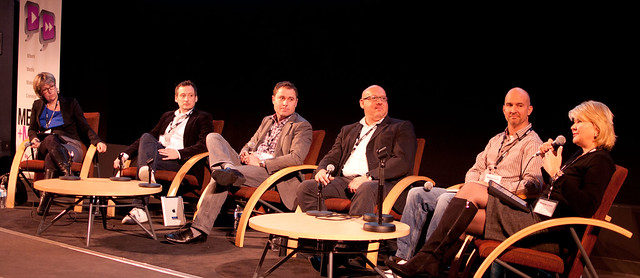
[Tools of Engagement panel, moderated by Gillian Shaw]
TOOLS OF ENGAGEMENT, moderated by Gillian Shaw, Technology Journalist, The Vancouver Sun
Android is now the world’s largest operating system (with a 20% share in Canada).
New Amsterdam Media’s focus is between large companies (Disney, Time Warmer) and augmented reality and gaming companies.
Steve Bocska (Pug Pharm) Ice Pilots: A unique gaming product in that you can keep collecting new items each week online – moving inventory to a board (users answer analytics unwittingly in this case). The big payoff: items on top will allow users to engage with others who find these are the best pilots as well.
How do you create game play vs. engagement, which are similar but different in their own ways?
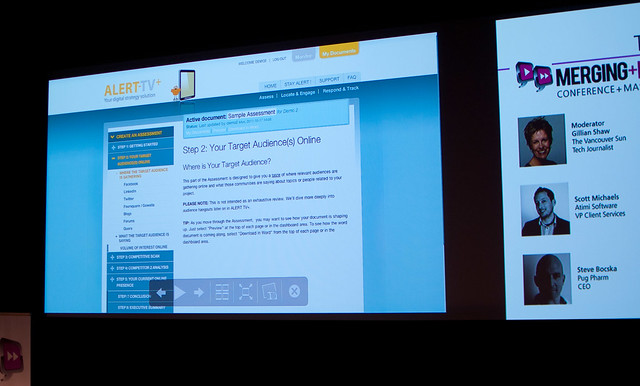
[Altert TV Plus (ATV+), an online service introduced by Moyra Rodger (CEO, Magnify Digital)]
Alert TV exists in the cloud. There’s an automated dashboard that shows what is being said about a TV show or series based on keywords. The program can create both weekly and monthly reports.
A subscription-based service, it’s easy to set up and costs between $300-500 dollars/month (including ongoing training).
At least one third of mobile users multitask while watching TV.
Social stream is now more active. The “side show” is a lot more interesting, but does media “get” this multidimensional experience?
The web model: “You take the most valuable thing that you have and give it away for free”. It’s the user engagement that provides the possibility for revenue.
…And another networking lunch underway!
CONVERGENCE GURU HENRY JENKINS GOES CRYSTAL BALL GAZING via Skype, with Simon Pulman, a Starlight Runner Entertainment consultant
The use of catchy pop culture iconography can be shared across social networks. Capitalism can take a page from the Occupy Wall Street movement’s book.

[Henry Jenkins via Skype, discussing spreadable media]
How are people mobilizing content and how are conversations measured? It’s now easier to spread content, but challenges still remain. We’re getting closer to viewer-supported TV.
Jenkins coined the term “participatory culture” 25 years ago when copy machines were the normal way of spreading media. The cost of production is now lower, making it easier to spread the message.
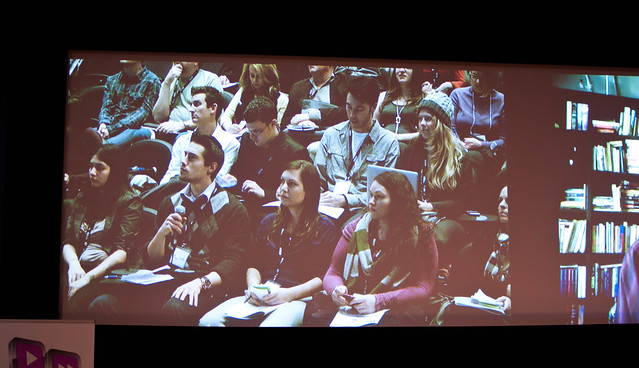
[Simon Pulman in audience with conference attendees, watching Henry Jenkins via Skype]
Web 2.0 is a business model that seeks to capture and commodify. Participatory culture on the other hand, is a movement. Jenkins advocates grassroots media and communication playing itself out to every available tool out there.
He’s frustrated over the US efforts to control copyrighted content. The balance is uneven. The Mickey Mouse Protection Act is outdated for modern culture. Death + 25 years as a copyright duration should be shortened. “You don’t give it all away, but you reflect the reality of a participatory culture.”
Fair use and copyright failure is mostly due to culture’s negotiating its moral contract. The digital divide is the tip of the iceberg. There’s a severe gap to knowledge and access to capital. A fight for public spaces (libraries, schools, and museums) to allow more access to technology is raging. Jenkins is currently trying to meet with educators in the Los Angeles Unified School District in order to change the access to technology. Facebook, YouTube, and Wikipedia need to be available to all, and not blocked in these public spaces.
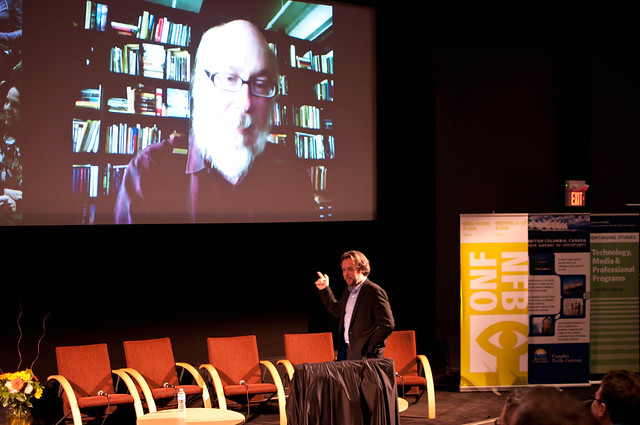
[Q&A session with Henry Jenkins]
The conference then wrapped up with announcing the winner of the 10K Merging Media 2011 Pitch 360 BC Film Award. Big congrats to MediaSphere, Pitch 360 winner for “Skid Row: The Great Fire”!
Networking and socializing continued into the evening with a reception at W2’s Media Café.
Find photos from Day 1 here and more photos from Day 2 here.
